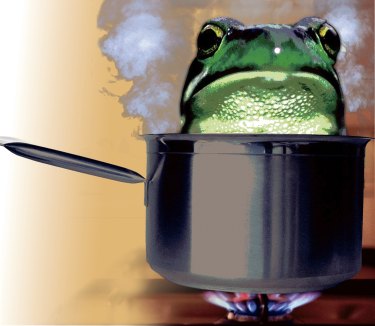Opinion
Why Aldi food prices are cheaper than Coles or Woolworths
By Joel Gibson
It has been said that if a frog jumps into a pot of hot water it will quickly leap out but, if it is a cold pot that is slowly heated, you could well end up with a cooked frog.
It is the same principle with our grocery bills. They can increase a little at a time for a while, and we barely notice – just a few cents on the milk, a dollar or two on that roast – until suddenly, we feel the searing heat.

Credit:Simon Bosch
Right now, the food price heat is well and truly rising.
In just a few months we have seen the average price of groceries jump 4 per cent.
Cauliflowers soared to as much as $8 after the east coast floods, and staples such as Arnotts biscuits (up 5 per cent to 10 per cent) and predictions for a 10 per cent to 20 per cent rise in the price of SPC baked beans and spaghetti, added to the pain.
Even in February, before the latest round of price rises, a year-on-year comparison of Coles and Woolworths websites by grocery price comparison website Frugl Grocery showed an average increase of 2.6 per cent, with some products such as instant coffee and soft drinks soaring between 50 per cent and 90 per cent.
Food is the second-largest household bill after either a mortgage or rent, so even a 4-5 per cent increase can cost up to $500 extra per year. And with mortgage payments now rising significantly, too, it is going to be more important than ever to save a few bucks where you can at the supermarket.
Aldi has commissioned new YouGov research, which found that groceries (51 per cent) and petrol (59 per cent) were the top two categories of cost of living concerns for Australians. Almost 40 per cent of those surveyed intend to reduce their food spend this year.
Aldi’s 2022 Price Report, released yesterday and based on data analysis by PricewaterhouseCoopers, found that an Aldi grocery basket is generally 15 per cent cheaper than a basket of the cheapest comparable products at its major competitors. That could result in a $1555 annual saving based on a weekly grocery bill of $192.
The biggest price gaps on grocery items are on chilled food (20 per cent) and meat (18 per cent).
Compared to name brands at its competitors, Aldi’s report says its basket is up to 25 per cent cheaper, which would be a $2468 annual saving.
The results are not far off a range of other comparisons: Consumer advocate Choice has repeatedly found Aldi to be 7-10 per cent cheaper than the Coles and Woolworths.
As consumer budgets tighten, more people might be looking to pocket these sorts of savings.
Coles and Woolworths are also responding to rising food prices with targeted discounting.
Coles says it “placed more than 530 new products on everyday low prices [from January to March], 31 per cent more than in the prior corresponding period” and that shopping for its weekly specials can save Flybuys members an average of $65 on their food basket each week.
Woolworths is adding 300 new popular products to its “prices dropped” category – up 34 per cent on the same period last year – and including more than 650 home-brand products to is “low price” category.
That pretty much sums up the price pitch of the three big supermarket chains: Aldi says it is cheaper in general, while Coles and Woolies say they have more discounts and specials. It is why my number-one tip is to shop at more than one outlet.
Whether it is changing supermarkets, or switching to home brands, our grocery shopping habits will have to change this year.
We will have to pay more attention to food prices and specials, unit pricing, and avoid food wastage, so as not to break the household budget bank.
Joel Gibson is the author of Kill Bills. Catch his money saving segments on Nine Radio, Today and on Twitter @joelgibson.